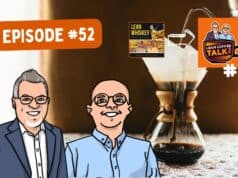 I'm pleased to present the latest in my Lean Thinker Q&A series, this time with Jamie Flinchbaugh, co-author of the recently-published book “The Hitchhiker's Guide To Lean
I'm pleased to present the latest in my Lean Thinker Q&A series, this time with Jamie Flinchbaugh, co-author of the recently-published book “The Hitchhiker's Guide To Lean.” Here is part #2 of our Q&A, below. Part #1 is here.
Jamie's full bio can be found here.
We're trying to do this Q&A in “small batch” format, with a few questions that we'll publish each week until we exhaust Jamie's willingness to answer questions, some from me, some from Luke. If you have questions for Jamie about lean or about his book, feel free to post comments on this post or use the Email link on the left to contact me.
——————————-
Q: You devote a chapter in your book to the idea of lean “operating systems.” If a company is getting started with lean, how should you balance the use of lean tools and lean thinking at a local level versus spending time defining a corporate lean “operating system?” Are most successful operating systems defined in advance or defined after the fact, as the Toyota Production System was documented?
A: To some degree, most companies already have an operating system. It defines how you work – your culture, skills, tools, processes and so on. It is perhaps one of the most misunderstood business concepts today. Many companies start lean transformation and launch their ‘operating system.' But how do you know how to build your operating system if you just began your journey?
Most operating systems that companies try to launch, under these conditions, turn into a piece of paper. You might need the piece of paper that helps communicate or teach the operating system, but a real operating system exists in the way people work, think, make decisions and solve problems.
I can think back to the Chrysler Operating System, which was a component of saving Chrysler during the early and mid-eighties. It had the paper version and the real version. For plant managers and executives who focused it on making it a part of how they do their own work, it stuck and made a difference. For those who focused on putting up posters of the Operating System, then the change didn't stick for very long at all.
You build a real operating system over time, one heart, one mind at a time.
Q: You also write about “lean for service industries” in your book. When you approach lean training and projects with people outside of manufacturing, do you them being accepting of ideas that come fromToyotaand the manufacturing world? Do you teach lean differently to service folks?
A: If you walk into someone's office and start preaching five S and u-shaped cells, you'll get thrown out on your you-know-what.
Having a CEO put a label on where her stapler goes doesn't change anything. And putting a surgical unit into a u-shape isn't going to be a lot of fun for the patient.
Applying lean to service processes is more than taking lean manufacturing solutions and force fitting them. Some of that is true. It is taking the principles and practices that create those solutions that we need to focus on more.
Practices such as kaizen can apply to any process, even if the resulting solutions are very different. And how we look for waste, understand the ideal state and provide simple and standardized practices for activities, connections and flows should be a daily activity, but again, will result in different solutions to different problems.
That is why we focus on teaching lean as a way of thinking, as a set of principles, and from that foundation you start worrying about the practices and tools and solutions.
But an important thing to keep in mind is that there are additional challenges in services processes. Just for starters, manufacturing is relatively easy to measure and easy to directly observe.
But try to observe accounts payable – it's not quite the same. Also, depending on the organization, you have to overcome some fundamental beliefs such as “we don't work in a process, we just do work” and “why would we want this to go faster?”
Q: Jim Womack has wrote a lot lately, as have others, on “what is wrong with the auto industry.” Do you agree with what Womack wrote, do you have different thoughts on this? What should Rick Waggoner and Bill Ford do in their roles? What role should lean play in their (hopeful) turnaround?
A: It's very convenient to pile on the Big 2 right now, because it's hard to argue with the conclusions. Let's first be clear about the problem – there is no one problem. Everyone wants to look for the big problem and the big solution. No one thing is going to turn around GM, and no one person will make it happen. This isn't to absolve leadership of their responsibility for this awful situation, but just to broaden the understanding and debate.
Let's first address lean – this is not a “lean manufacturing” problem. Take a look at quality, for example. In at least one quality study, both Jaguar (of Ford) and Buick (of GM) are in the top 4. And Buick has been there for a while. But, both brands are running on fumes in the market. With all the talk ofToyotaquality, yes it has an impact, but it's not the answer.
This isn't to say there isn't a quality problem. I recently saw the worst-built car I've ever seen, and it was a Ford Focus, which they've had 10 years to work out the kinks. Worst yet, it was on the showroom of a dealership.
What can we look at from a lean perspective? Value. The products you buy have to have value to the customer. Here, these companies are losing. Fundamentally, these companies are not designing cars that people want to buy, no matter what the price.
Many of the problems these companies face today are the results of decisions made many years ago. These companies, and the people in them, aren't stupid. But they do need bolder action, and they need to examine everything, as there isn't just one fix.
Please scroll down (or click) to post a comment. Connect with me on LinkedIn.
Let’s work together to build a culture of continuous improvement and psychological safety. If you're a leader looking to create lasting change—not just projects—I help organizations:
- Engage people at all levels in sustainable improvement
- Shift from fear of mistakes to learning from them
- Apply Lean thinking in practical, people-centered ways
Interested in coaching or a keynote talk? Let’s start a conversation.










[…] Here is Part #2 of the Q&A (3/23/06) Please check out my main blog page at http://www.leanblog.org […]